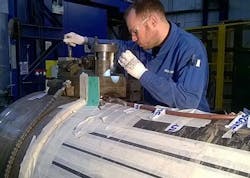Getting Back Online: Expertise and Speed Win Generator Repair Project
By: Alex Edwards, Marketing & Communications Manager, Rotating Equipment Services, Sulzer
Generators are expected to provide long and reliable service, especially when they make up part of the national power grid. Any repairs need to be completed quickly to minimize loss of supply on the power network. When a generator supporting the national grid in Cyprus needed a rapid repair Sulzer’s expertise and in-house facilities were key to delivering the project on time.
Even with the most demanding maintenance routines, unexpected failures can still occur, making a fast repair essential to keep power generation facilities online and ensure service is maintained for businesses and households alike. Considering that this 75 MW generator alone produces sufficient energy for around 90,000 homes, there was a definite sense of urgency to ensure electricity supplies were maintained.
In this case, the generator had suffered an unexpected catastrophic failure and there was an immediate need to complete a repair. As part of the national power supply grid, the procedures for employing maintenance contractors are clearly set out and require a rigorous tendering process to be followed. Sulzer was the quickest to respond to the customer’s distress and was able to dispatch a team of engineers to carry out initial tests and inspections to assess the level of damage.
Delivering the assessment
The proposal for inspection from Sulzer was accepted and the contract to assess the generator was awarded. The engineering team removed the rotor and shipped it to Sulzer’s service center in Birmingham, UK, before starting the full assessment of the stator on site.
An inspection report was issued to the customer highlighting the findings with the recommended levels of work required to get the unit back to a safe operating condition. Sulzer accepted the customer’s request to use the report as the backbone for their tender document. This was issued to all suitably qualified repair specialists including original equipment manufacturers (OEMs) and maintenance providers.
Aneil Hanafiah, Mechanical Design Manager at the Birmingham Service Center, explains: “Sulzer offered a very competitive tender that was accepted as a result of the extensive technical expertise, the overall price and the speed with which the repair would be completed. A range of solutions for the repair of the generator was provided, and in this case speed and cost led the customer to choose partial insulation as opposed to a complete overhaul or total re-insulation.”
Reverse engineering saves time
The cause of the failure was due to the main circuit breaker being closed whilst the rotor was stationary. This effectively allows high currents to flow through the stator, inducing a current in the rotor. Without centrifugal force, a high resistance is created between the rotor components, generating excessive heat, which can cause permanent damage to the rotor.
In this case, the damper circuit on the rotor took the brunt of the force which deformed and welded itself to the rotor retaining ring. Using their mechanical expertise, Sulzer’s engineers had to precision-machine the retaining rings in order that they could be removed. However, now new retaining rings were required.
In machines of this size, obtaining new components, such as retaining rings, from the OEM can take months. Due to the urgency of the repair, the parts were needed sooner to bring the generator back online. Fortunately, Sulzer has the capability to reverse engineer these parts using laser scanning technology, material analysis, and extensive machining facilities.
Having removed the retaining rings, Sulzer tested the retaining ring landing areas to determine that no microscopic properties had changed, and the forged material was metallurgical stable and safe. At the same time, the rotor was fully assessed mechanically using various industry-standard methods which confirmed that rehabilitation of this rotor was feasible.
All of the mechanical tests were carried out without the removal of any field coils which when tested electrically were confirmed to be healthy.
Recreating parts
The rotor had also suffered damage to the composite bronze coil wedges, which had melted, distorted and fragmented due to the fault incident, causing molten particles to contaminate the stator due to the internal circulating air. Using a similar process to the retaining rings, the rotor wedges were reverse engineered and those that could be reused were tested and refurbished as per the customer’s instructions.
While the new components were being manufactured the rotor coils were inspected and the slot liners were replaced without having to remove the copper coils, which reduced the time for the overall repair. Throughout the repair, the customer received regular, weekly reports and visited the Birmingham Service Center twice during the repair.
Meanwhile, in Cyprus, the field service engineers worked to thoroughly clean and repair the stator, which had been damaged and contaminated by the rotor wedges. Once all the foreign materials had been removed, the stator was tested for core imperfections before reassembly with the rotor.
Before the rotor could be shipped back to the power station, it was balanced using Sulzer’s in-house high-speed balance facility. This is able to balance the rotor at its rated speed (3’000 rpm) and for this rotor in particular, an overspeed exercise was performed for two minutes at 115% (3’450 rpm), as requested by the customer. As a result of the precision processes involved, there was no need to carry out any additional trim balancing after the rotor was reassembled with the stator.
Aneil concludes: “Of course, in projects such as this, speed is important and the ability to deliver such projects on time requires considerable expertise and flexible facilities. Especially when a project is under competitive tender, the repairs need to be completed on time and to budget, even when major components need to be replaced. We have managed to repair a major asset that will ensure tens of thousands of local residents can rely on their power company to continue delivering a vital resource.” for Sulzer


